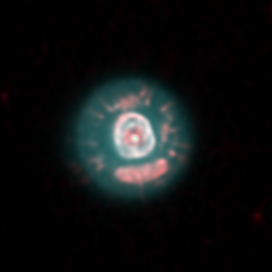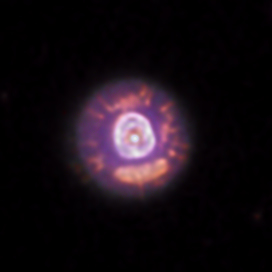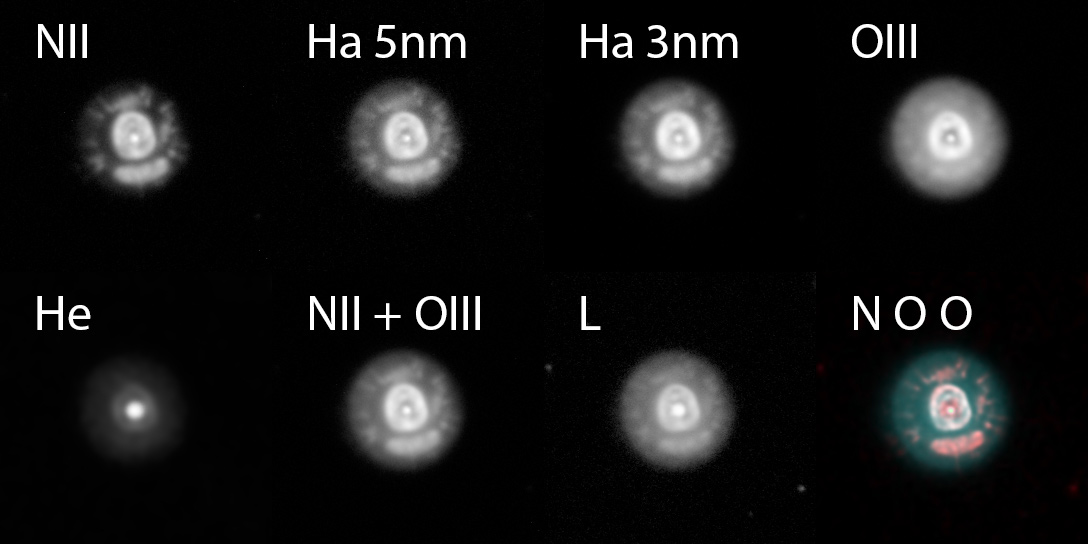I'd planned to image a very faint planetary binned x 4, but felt compelled to shoot something binned x 1 when I realized the seeing was good.
NGC 2392 was the only bright planetary i could think of off of the top of my head
so decided to give it a shot unbinned with the NII filter
so decided to give it a shot unbinned with the NII filter which gave great detail in the reds
NII OIII:
the source of the NII globules is still a bit of a mystery
Kitchen sink pallet--NII red, Ha green, OIII blue, He magenta:
just for fun i gathered a few exposures with a variety of filters (thanks to bilgebay for the 3 nm Ha data):
minimal processing, just digital development, except the last.
note the lack of detail in the OIII, with even less in the HeII
while NII + OIII is remarkably similar to Ha
(bill w's conjecture Ha~NII+OIII for PN, Ha~SII+OIII for emission nebulae).
Filter digression:
In general, the narrower the bandwidth of the filter, the better the signal to noise ratio (assuming your exposure is long enough to bring out background signal). I touched on this in prior post covering the rationale behind narrow band filters in light polluted skies.
However, narrower isn't always better. traditional "Ha" filters typically capture Ha emissions at 656 nm and NII at 658 nm (older papers refer to them as Ha + NII). The new astrodon 3 nm Ha filters, in theory cut out a portion of the NII signal, which is not desirable when imaging planetary nebulae.
bilgebay recently captured an image with very similar equipment, but used a 3 nm Ha filter (656 nm).
he was kind enough to send me the Ha data for comparison as i was curious to see how much loss of NII signal (658 nm) affected the image. not quite a perfect comparison as he used >4x the exposure time for his subs, while i probably had better seeing. you can see the comparison in the mosaic above. the difference isn't as great as i'd expected, but there is definitely better contrast between the "eskimo's fur" and the circular nebulosity in the broader 5 nm Ha image.
8" LX200R, SX Trius 694 binned 0.4"/px
astrodon 5nm Ha, 3nm OIII, 3 nm NII, chroma 4 nm He
ASA DDM60
Ha 5x5 min, OIII 8x5 min, HeII 14x 5 min, NII 30 x 5 min, L 14 x 1 min
2/11,12,16/16
eastbluff, CA
no calibration except luminance ;)
Ha 3 nm 7 x 20 min
Celestron C8 Edge HD, Atik 460 EX Mono, astrodon 3 nm Ha
Bilgebay Observatory, Mugla, Marmaris, Turkey
interestingly, sedat used also used an 8" SCT with the Sony ICX694 chip.
Try increasing gamma if dark sections aren't distinguished
Sunday, March 6, 2016
Sunday, February 21, 2016
Abell 78 where's the helium?
first, a more aesthetically pleasing version in Ha OIII OIII, then the helium:
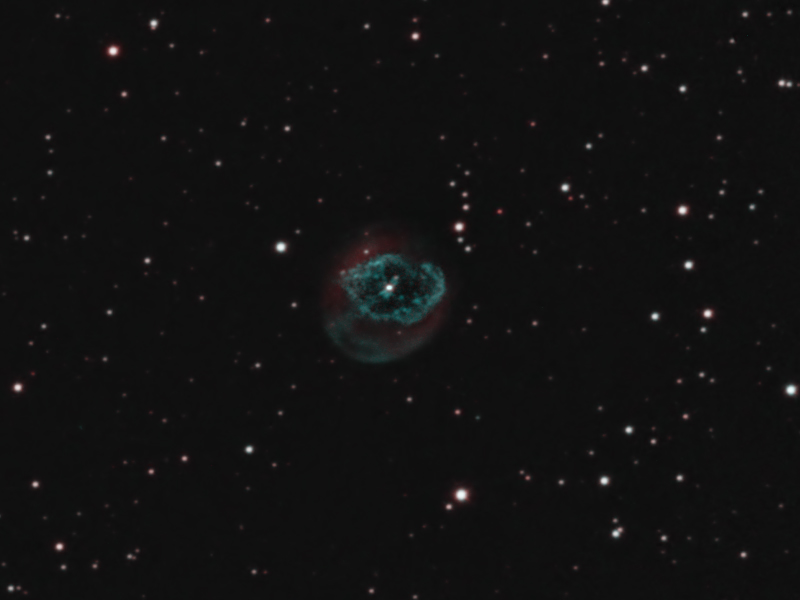
Abell 78 is a rare type of planetary nebula who's exhausted central star ran out of hydrogen to burn (fuse) and collapsed, only to reignite--fusing helium rather than hydrogen at it's surface. this is reflected in the unusual shape of the planetary nebula: a smooth outer shell formed initially, followed by a complex inner shell shaped by the much faster helium wind. note the filaments (not diffraction spikes) streaming from the central star.
faint ring in Ha (hydrogen):
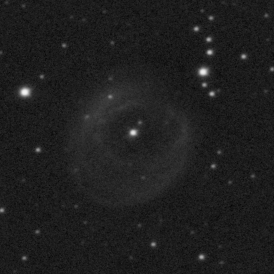
complex shell with inner jets and stream leading to outer shell (bottom) in OIII (oxygen)
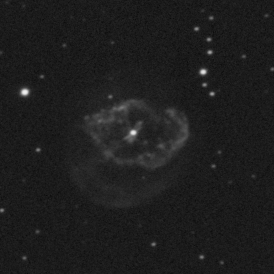
very faint in Helium II
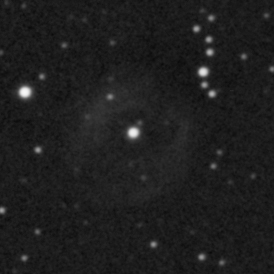
Ha OIII He image
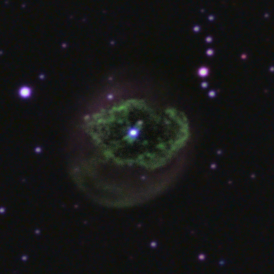
with the helium giving not much more than a magenta cast to the outer shell especially upper left
mosaic:
top: Ha OIII He
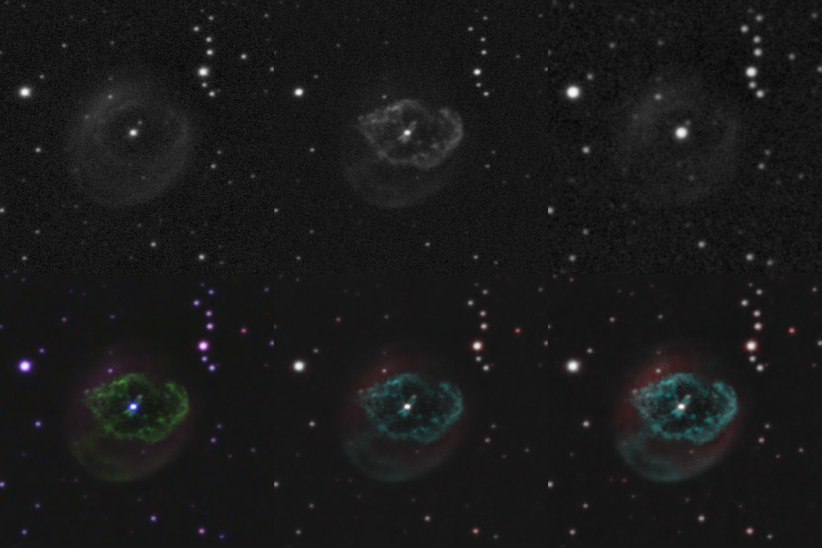
bottom: HOHe HOO HOO (bright)
a number of sources indicate that the inner ring is mostly made up of helium
http://www.noao.edu/...y/abell_78.html
https://en.wikipedia.org/wiki/Abell_78
http://www.astrosurf...78/abell78.html
i am at a loss to explain this as the helium was so faint relative the the Ha and OIII that i had to bin x 4 to pick anything up (this is what prompted the 4x binning further tested in my last post).
the last link also makes the helium claim and includes the 2d spectrum of the nebula, but by my reading, the He line is much more faint than the Ha and OIII.
where is the all the helium? what am i missing? are they referring to He I? or the central star itself?
any input would be appreciated.
8" LX200R, SX Trius 694 binned x2 to 0.8"/px, binned x4 to 1.6"/px, (final image at .8"/px)
astrodon 5nm Ha, 3nm OIII, chroma 4 nm He
ASA DDM60
Ha 30x20 min bx2, OIII 48x20 min bx2 (best 26 used for RL deconvolution)
HeII 4x20 min bx2, 1x 40 min bx2, 59x20 min bx4
9/23/15-11/14/15
eastbluff, CA

Abell 78 is a rare type of planetary nebula who's exhausted central star ran out of hydrogen to burn (fuse) and collapsed, only to reignite--fusing helium rather than hydrogen at it's surface. this is reflected in the unusual shape of the planetary nebula: a smooth outer shell formed initially, followed by a complex inner shell shaped by the much faster helium wind. note the filaments (not diffraction spikes) streaming from the central star.
faint ring in Ha (hydrogen):

complex shell with inner jets and stream leading to outer shell (bottom) in OIII (oxygen)

very faint in Helium II

Ha OIII He image

with the helium giving not much more than a magenta cast to the outer shell especially upper left
mosaic:
top: Ha OIII He

bottom: HOHe HOO HOO (bright)
a number of sources indicate that the inner ring is mostly made up of helium
http://www.noao.edu/...y/abell_78.html
https://en.wikipedia.org/wiki/Abell_78
http://www.astrosurf...78/abell78.html
i am at a loss to explain this as the helium was so faint relative the the Ha and OIII that i had to bin x 4 to pick anything up (this is what prompted the 4x binning further tested in my last post).
the last link also makes the helium claim and includes the 2d spectrum of the nebula, but by my reading, the He line is much more faint than the Ha and OIII.
where is the all the helium? what am i missing? are they referring to He I? or the central star itself?
any input would be appreciated.
8" LX200R, SX Trius 694 binned x2 to 0.8"/px, binned x4 to 1.6"/px, (final image at .8"/px)
astrodon 5nm Ha, 3nm OIII, chroma 4 nm He
ASA DDM60
Ha 30x20 min bx2, OIII 48x20 min bx2 (best 26 used for RL deconvolution)
HeII 4x20 min bx2, 1x 40 min bx2, 59x20 min bx4
9/23/15-11/14/15
eastbluff, CA
Subscribe to:
Posts (Atom)
